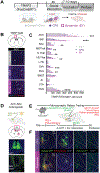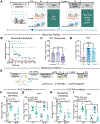Anterior cingulate inputs to nucleus accumbens control the social transfer of pain and analgesia
- PMID: 33414216
- PMCID: PMC7952019
- DOI: 10.1126/science.abe3040
Anterior cingulate inputs to nucleus accumbens control the social transfer of pain and analgesia
Abstract
Empathy is an essential component of social communication that involves experiencing others' sensory and emotional states. We observed that a brief social interaction with a mouse experiencing pain or morphine analgesia resulted in the transfer of these experiences to its social partner. Optogenetic manipulations demonstrated that the anterior cingulate cortex (ACC) and its projections to the nucleus accumbens (NAc) were selectively involved in the social transfer of both pain and analgesia. By contrast, the ACC→NAc circuit was not necessary for the social transfer of fear, which instead depended on ACC projections to the basolateral amygdala. These findings reveal that the ACC, a brain area strongly implicated in human empathic responses, mediates distinct forms of empathy in mice by influencing different downstream targets.
Copyright © 2021, American Association for the Advancement of Science.
Conflict of interest statement
Figures





Comment in
-
How mice feel each other's pain or fear.Science. 2021 Jan 8;371(6525):122-123. doi: 10.1126/science.abf5940. Science. 2021. PMID: 33414207 No abstract available.
-
Feeling another's pain.Nat Rev Neurosci. 2021 Mar;22(3):133. doi: 10.1038/s41583-021-00438-8. Nat Rev Neurosci. 2021. PMID: 33547450 No abstract available.
References
-
- Hoffman ML, Developmental synthesis of affect and cognition and its implications for altruistic motivation. Develop. Psychol 11, 607–622 (1975).
-
- de Waal FBM, Putting the altruism back into altruism: the evolution of empathy. Annu. Rev. Psychol 59, 279–300 (2008). - PubMed
-
- Sivaselvachandran S, Acland EL, Abdallah S, Martin LJ, Behavioral and mechanistic insight into rodent empathy. Neurosci. Biobehav. Rev 91, 130–137 (2018). - PubMed
-
- Keum S et al., Variability in empathic fear response among 11 inbred strains of mice. Genes, Brain, Behav 15, 231–242 (2016). - PubMed
Publication types
MeSH terms
Substances
Grants and funding
LinkOut - more resources
Full Text Sources
Other Literature Sources
Medical
Molecular Biology Databases

